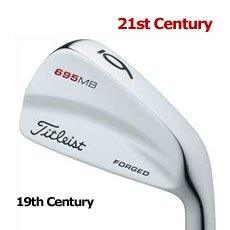History Of The Blade / Tour Iron

The earliest golf clubs were constructed of wood, because iron clubs would have damaged the leather, feather-stuffed golf balls being used back then. However, right around the middle of the 19th century, a harder ball was developed, called the Gutta-percha, which was made out of a rubbery substance that comes from a tree in Malaysia. Because of these new, more durable balls, club heads began being constructed out of iron, even though the shafts continued to be made of wood until the early 1900s.
The benefits of using iron constructed heads were profound because the iron heads could be shaped differently. The faces could be formed at a higher angle to produce shorter, high-trajectory shots without losing any strength. While wooden clubs continued to stay in the game, even to this day, they were used primarily for longer, low-trajectory shots. Originally, iron club heads were forged by hand, usually by a blacksmith. They get the name "blades" because early irons constructed this way really did look like a blade due to their angular features. As time progressed, the process of forging blades became somewhat more sophisticated, even though blades today still have the same core features as those that were made 150 years ago.
From the 1940s through the 1970s, blade irons were the golf standard. From the 1980s and up through today, other more-forgiving clubs have started to become more popular. This is perhaps because of new advances in club design and technology that allow new clubs to perform nearly as well as traditional blade irons while still being forgiving and consistent. Until recently, forged clubs were synonymous with blade clubs, but nowadays there are cavity back clubs that can be forged as well.
Also, it's interesting to note that the today's clubs have different lofts than clubs that were made 10 to 15 years ago. Because of this shift in the loft, a 7 iron today is what used to be an 8 iron back then. The difference is that the ball typically carries farther with the increased lofts. However, just because it gets a little bit more distance doesn't necessarily mean that the ball goes any straighter. In fact, Tiger Woods uses a set of clubs with the same lofts as the irons of the 70s.
Despite being considered some of the most traditional golf clubs, the future of blade irons is somewhat uncertain. It's expected that the number of recreational golfers will continue to grow as it has during the past few decades, and as a result, clubs that have been specially designed for mid to high handicap golfers in order to make the game more enjoyable will also become more prevalent. Even among the pros, the blade irons are beginning to lose their popularity.
However, being some of the first iron golf clubs, blade irons are a staple of the golf world. While it is true that some professionals are beginning to favor game-improvement clubs (http://www.gameimprovementirons.com/), thus far no other club on the market is able to offer the buttery soft feel that forged blades are famous for. Until that day comes, blades will continue to be favored by many professional golfers so they can get the feel and performance they're used to, along with the simple, traditional appearance.
Related Guides
What Are Blade Irons?
Why Use Blade Irons
Blade Irons Vs Cavity Back Irons
The Blade Iron Set - A Look Inside
Left Handed Blade Irons - A Look At The Market
How To Hit (use) Blade Irons
Blade Iron Reviews